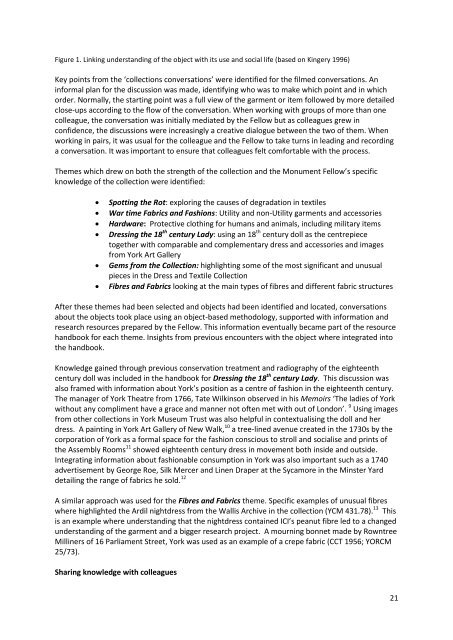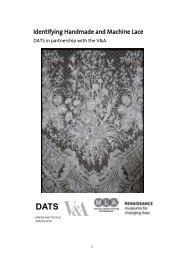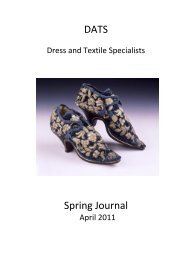Spring 2012 - Dress and Textile Specialists
Spring 2012 - Dress and Textile Specialists
Spring 2012 - Dress and Textile Specialists
You also want an ePaper? Increase the reach of your titles
YUMPU automatically turns print PDFs into web optimized ePapers that Google loves.
Figure 1. Linking underst<strong>and</strong>ing of the object with its use <strong>and</strong> social life (based on Kingery 1996)<br />
Key points from the ‘collections conversations’ were identified for the filmed conversations. An<br />
informal plan for the discussion was made, identifying who was to make which point <strong>and</strong> in which<br />
order. Normally, the starting point was a full view of the garment or item followed by more detailed<br />
close-ups according to the flow of the conversation. When working with groups of more than one<br />
colleague, the conversation was initially mediated by the Fellow but as colleagues grew in<br />
confidence, the discussions were increasingly a creative dialogue between the two of them. When<br />
working in pairs, it was usual for the colleague <strong>and</strong> the Fellow to take turns in leading <strong>and</strong> recording<br />
a conversation. It was important to ensure that colleagues felt comfortable with the process.<br />
Themes which drew on both the strength of the collection <strong>and</strong> the Monument Fellow’s specific<br />
knowledge of the collection were identified:<br />
<br />
<br />
<br />
<br />
<br />
<br />
Spotting the Rot: exploring the causes of degradation in textiles<br />
War time Fabrics <strong>and</strong> Fashions: Utility <strong>and</strong> non-Utility garments <strong>and</strong> accessories<br />
Hardware: Protective clothing for humans <strong>and</strong> animals, including military items<br />
<strong>Dress</strong>ing the 18 th century Lady: using an 18 th century doll as the centrepiece<br />
together with comparable <strong>and</strong> complementary dress <strong>and</strong> accessories <strong>and</strong> images<br />
from York Art Gallery<br />
Gems from the Collection: highlighting some of the most significant <strong>and</strong> unusual<br />
pieces in the <strong>Dress</strong> <strong>and</strong> <strong>Textile</strong> Collection<br />
Fibres <strong>and</strong> Fabrics looking at the main types of fibres <strong>and</strong> different fabric structures<br />
After these themes had been selected <strong>and</strong> objects had been identified <strong>and</strong> located, conversations<br />
about the objects took place using an object-based methodology, supported with information <strong>and</strong><br />
research resources prepared by the Fellow. This information eventually became part of the resource<br />
h<strong>and</strong>book for each theme. Insights from previous encounters with the object where integrated into<br />
the h<strong>and</strong>book.<br />
Knowledge gained through previous conservation treatment <strong>and</strong> radiography of the eighteenth<br />
century doll was included in the h<strong>and</strong>book for <strong>Dress</strong>ing the 18 th century Lady. This discussion was<br />
also framed with information about York’s position as a centre of fashion in the eighteenth century.<br />
The manager of York Theatre from 1766, Tate Wilkinson observed in his Memoirs ‘The ladies of York<br />
without any compliment have a grace <strong>and</strong> manner not often met with out of London’. 9 Using images<br />
from other collections in York Museum Trust was also helpful in contextualising the doll <strong>and</strong> her<br />
dress. A painting in York Art Gallery of New Walk, 10 a tree-lined avenue created in the 1730s by the<br />
corporation of York as a formal space for the fashion conscious to stroll <strong>and</strong> socialise <strong>and</strong> prints of<br />
the Assembly Rooms 11 showed eighteenth century dress in movement both inside <strong>and</strong> outside.<br />
Integrating information about fashionable consumption in York was also important such as a 1740<br />
advertisement by George Roe, Silk Mercer <strong>and</strong> Linen Draper at the Sycamore in the Minster Yard<br />
detailing the range of fabrics he sold. 12<br />
A similar approach was used for the Fibres <strong>and</strong> Fabrics theme. Specific examples of unusual fibres<br />
where highlighted the Ardil nightdress from the Wallis Archive in the collection (YCM 431.78). 13 This<br />
is an example where underst<strong>and</strong>ing that the nightdress contained ICI’s peanut fibre led to a changed<br />
underst<strong>and</strong>ing of the garment <strong>and</strong> a bigger research project. A mourning bonnet made by Rowntree<br />
Milliners of 16 Parliament Street, York was used as an example of a crepe fabric (CCT 1956; YORCM<br />
25/73).<br />
Sharing knowledge with colleagues<br />
21





